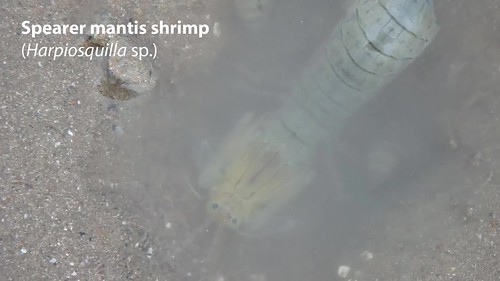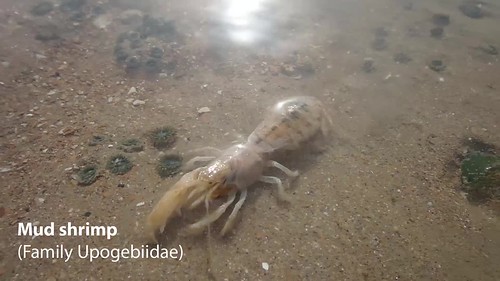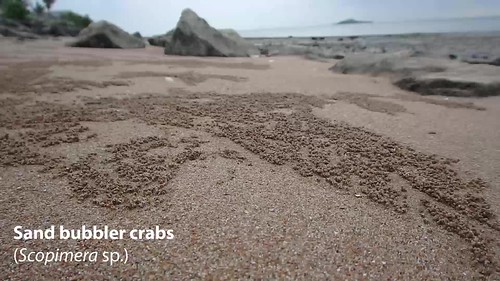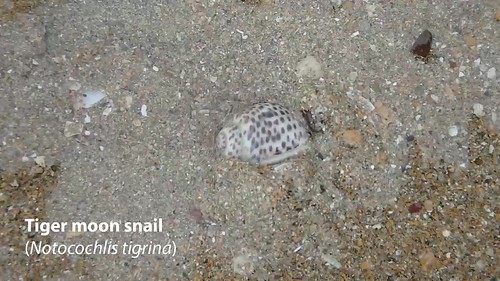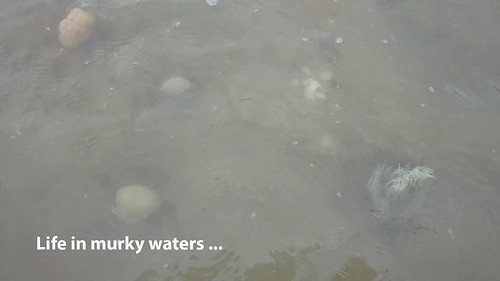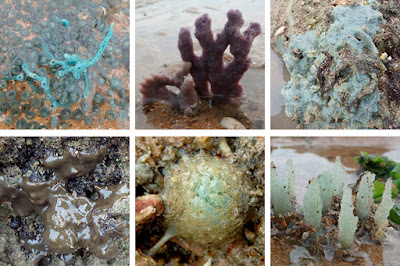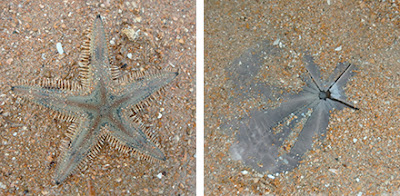
This special sliver of shore is all that is left of Singapore's natural western reefs. Kok Sheng shared this photo of what Merawang looked like before the Tuas reclamation, at the map exhibition at the National Library.
 |
| Photo shared by Loh Kok Sheng. |
 |
| Singapore's western coast in a 1927 map, Image from Jerome Lim's blog. |
 |
| From Noel Murphy's blog. |
There are more mangrove trees growing on the higher shores.
Some parts of the shore have lots of dead coral rubble (remains of our last great western reef?). I saw two Haddon's carpet anemones and some small patches of Spoon seagrass.
This tiny mangrove seedling has settled on the mid-shore among some Spoon seagrass.
This shore goes all the way to Raffles Marina about 1.5km away.
Here's a closer look at shore near Raffles Marina.
Skipping among the waves were little Gold-spotted mudskippers.
On this stretch of shore, I saw a lot of these tiny Onch slugs. They move quite rapidly, leaving trails of poop.
On the mangrove trees, there were various Periwinkle snails and many of the tree trunks were encrusted in barnacles.
I didn't see many snails on the rubbly area. Only one Spiral melongena and none of their egg capsules. I did see some Drills, not many kinds and not in large numbers. On the sandy shores, I saw one Olive whelk and some Common whelks. Under the stones, there were some top shell snails.
Under the stones there is more life. I saw several tiny young Estuarine moray eels! In the pools, there were many Shadow gobies.
Small blobs, probably Lined bead anemones. And lots and lots of porcelain crabs.
There were many Crown sea stars under the rocks throughout the shore. But I didn't manage to find the Cryptic sea stars that we saw on our last trip here in Jun 2015.
There were many tiny Xanthid crabs under the stones, as well as a few small Stone crabs. I also saw some Snapping shrimps. In the mangrove trees, I saw some Purple climber crabs. I saw only one Orange-striped hermit crab.
On Sunday, I did the western part of this shore which we usually do on our previous surveys. There were more Haddon's carpet anemones on this stretch of the shore. In one anemone, I saw many Tiny carpet anemone shrimps.

I saw a Spearer mantis shrimp scramble out of a pool of water towards the sea where it promptly began burrowing into the sand.
I also saw a Mud shrimp. It was foraging on the shore, like a little excavator, digging furiously at good spots for food.
On the sandy patches there were Sand bubbler crabs. As well as fiddler crabs.
Tiger moon snails are still commonly seen on this shore. I also saw one sand collar, the egg mass of moon snails.
Most of the western shoreline is very sandy now without any seagrasses or seaweeds. A layer of silt settles on the areas with pools of water.
There are still some small patches of Spoon seagrass near the mid-water mark.
The Spoon seagrasses I saw were mostly the large-leaved kind and were mostly healthy looking without much epiphytes growing on the leaves. The seagrasses and shores at Tuas Merawang Beacon are monitored by TeamSeagrass volunteers from MSD, led by Sheryl.
The water was murky so I couldn't go into deeper water to check out the sea fans and other marine life we saw on our last trip here in Jun 2015. But there was still a lot of animals in the murky water!
Here, there are still lots and lots of tiny to small Ball flowery soft corals, and many small bunches of Spiky flowery soft corals of various colours. And many cerianthids aka 'Peacock anemones. I saw one small clump of Starry leathery soft corals.
I saw two Long black sea cucumbers, one Garlic bread sea cucumber and several buried Ball sea cucumbers.
The most abundant seaweed was Ulva and Caulerpa verticillata. There were sprinkles of various seaweeds including Neomeris, Halimeda, Caulerpa peltata, Caulerpa serrulata, Caulerpa taxifolia, Avrainvillea erecta. There was also some Padina and Acanthophora.
I did not see many sponges on the shore. I only saw tiny clumps of a few kinds of sponges.
I saw one Painted sand star and one dead Cake sand dollar.
There were shaggy carpets of Gregarious tube worms and some Solitary tube worms. On the rubble, I saw many Short ribbon worms.
Just across the Johor Strait, close to the Merawang Beacon, is the Forest City reclamation in Johor. Compared to what we saw in Mar 2015 and Jun 2015, the reclaimed area looks bigger and there appears to be construction going on the reclaimed area.
There are huge piles of sand being unloaded from enormous barges.
It appears trees are also being planted and structures being built on the newly reclaimed land.
Another view of the construction on the reclaimed land.
What's going on?
Here's some graphics of the Forest City reclamation from recent media articles.
 |
| From Straits Times, 19 Mar 15 |
 |
| From The Malaysian Insider, on Today Online 19 Mar 15. |
















